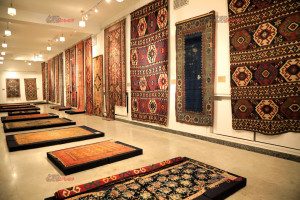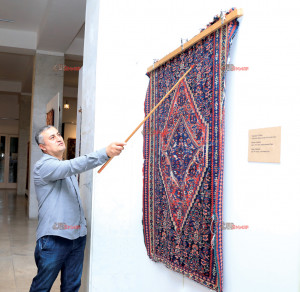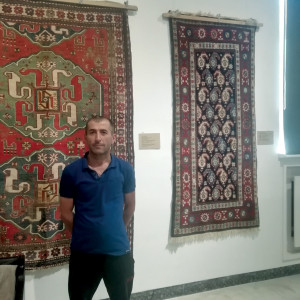RESCUING SHUSHI CULTURAL HERITAGE…
 The issue of preserving and publicizing the cultural relics of Artsakh is more relevant and important today than ever before. After the last war, when an attempt is made to assess the scale of the loss of pre-war cultural monuments in Artsakh, the picture seems more than depressing. At the same time, given the aspirations of our “neighbors” and the policy of consistent and continuous pursuit of cultural appropriation, it becomes clear that the fates of many important cultural monuments left “on the other side of our house” are vague and catastrophic. The issue of the rich heritage of this rare Armenian cultural center in Shushi, which came under Azerbaijani control, is especially relevant, where, as it is known, the destruction of Armenian cultural monuments or the transformation of “historical Azerbaijani heritage” into its own “traces” is in full swing creation work.
The issue of preserving and publicizing the cultural relics of Artsakh is more relevant and important today than ever before. After the last war, when an attempt is made to assess the scale of the loss of pre-war cultural monuments in Artsakh, the picture seems more than depressing. At the same time, given the aspirations of our “neighbors” and the policy of consistent and continuous pursuit of cultural appropriation, it becomes clear that the fates of many important cultural monuments left “on the other side of our house” are vague and catastrophic. The issue of the rich heritage of this rare Armenian cultural center in Shushi, which came under Azerbaijani control, is especially relevant, where, as it is known, the destruction of Armenian cultural monuments or the transformation of “historical Azerbaijani heritage” into its own “traces” is in full swing creation work.
Today I will tell you about how during the hottest day of the war artifacts were evacuated and saved from the Shushi Carpet Museum due to the compassionate attitude and heroism of individuals. The founder of the Carpet Museum, Vardan Astvatsatryan, and Armen Khachatryan, who voluntarily enlisted during the last war, managed to enter Shushi on November 1 in complete darkness, without turning on the car lights, saving most of the important specimens from the carpet museum. Today, 71 of the 160 carpets that have already been evacuated are on display at the Alexander Tamanyan National Museum-Institute of Architecture in Yerevan.
I met Vardan Astvatsatryan, the founder of the Shushi Carpet Museum, at the exhibition. He told a group of foreign tourists about the origins of carpets, explained the symbolic content of their ornaments. He undertook the mission of collecting and documenting these gems of ancient Armenian carpet weaving even before the first Artsakh war.
“Back in Soviet times,” says Vardan, “Azeris and Turks walked through the villages of Artsakh, buying old carpets or exchanging them for new ones.” I foresaw the trend to create their own cultural basis on the basis of our old carpets, as they are a newly formed nation. They have to write a story about their “deep roots” in those areas. I realized that some of our carpet weaving patterns would thus be completely forgotten, so I decided to address this issue.
Vartan says that the choice of patterns was guided by the strong principle that the origins and origins of carpets must be clearly dated and located. This is where the museum value of these unique exhibits comes into play. The carpet museum in Shushi was founded in 2011 on the initiative of Vardan Astvatsatryan.
– What is the oldest sample on display?
17th century carpet from Shosh village. I must mention that our carpets also had an educational and aesthetic significance. In the language of modern times, they were “mass media”. The carpets not only solved everyday problems, but also conveyed high moral and aesthetic values to the people.
 The main samples on display are the star carpets. They symbolize the human desire to look to heaven, to God. Some of the carpets also show the stages of Creation. Many of the exhibits reflect folklore. flower rugs, picture rugs, etc. In general, ornaments are universal values. Elements of individual ornaments can be found in the carpets of different peoples, they have mainly developed in one particular direction. But carpets have a different peculiarity for Armenians. They are very rich. There is not a single pattern that is not found on our carpets. The bee is a very powerful symbol. In our Armenian traditions, this symbolizes the image of the grandmother, her central role in the family.
The main samples on display are the star carpets. They symbolize the human desire to look to heaven, to God. Some of the carpets also show the stages of Creation. Many of the exhibits reflect folklore. flower rugs, picture rugs, etc. In general, ornaments are universal values. Elements of individual ornaments can be found in the carpets of different peoples, they have mainly developed in one particular direction. But carpets have a different peculiarity for Armenians. They are very rich. There is not a single pattern that is not found on our carpets. The bee is a very powerful symbol. In our Armenian traditions, this symbolizes the image of the grandmother, her central role in the family.
We have carpets from all regions of Artsakh here. We have exhibits from the village of Skar in Ijani, brought to Armenia by immigrant Armenians from Western Armenia. Everyone’s origin is clear. If I could not get complete information about any of the specimens, I would not be involved in the museum. During the war we evacuated 160 carpets from Shushi, 30 samples of pottery 4-5000 years old and 50 paintings. About 100 carpets, 90 pottery could not be extracted: Stone Age, Bronze Age, Middle Ages. However, we managed to save the main valuable carpets.
When I realized that the situation was fatal, I called the municipality and said that a car was needed. I asked them to send me late so that we would not go unnoticed by the drones. Armen was sent as a driver, for which I am very happy. My friend Armen and I were in Shushi and we met two soldiers who also helped us take out the carpets. We used to find the necessary carpets by phone lights. Thanks to the courage and mastery of our driver, Armen, we managed to take out the carpets, because without turning on the lights managed to drive all the way. I could not return with him that day, I said. “Dear Armen, you are carrying a large cultural layer in your car. “Look to get to a safe place.” Answered. “Calm down. Do not doubt for a second! I will make it.”
♦♦♦
39-year-old Armen Khachatryan is from Stepanakert. He is married, has 4 children, two daughters and two sons. The youngest is five years old, the oldest is 12. On the very first day of the war, September 27, he applied to the Stepanakert municipality of Artsakh to volunteer for the war in his own car, participating in the transportation of food, ammunition, the wounded and the dead. In 2016, in the same car, again as a volunteer, he went through the April war.
 “I was not called to the gatherings,” says Armen. “I suppose, as a father of many children, they did not want to take me.” I also thought that if they did not call me, I would go and introduce myself.
“I was not called to the gatherings,” says Armen. “I suppose, as a father of many children, they did not want to take me.” I also thought that if they did not call me, I would go and introduce myself.
From September 27 to October 1, Armen was involved in feeding the positions of the defensive zone in the direction of Martakert. Then he performed his service in all directions: Martuni, Hadrut, Askeran…
“I always saw their drones on the roads,” Armen recalls the war days.
In recent days he has been supplying Shushi.
– On October 28-30, we were evacuating people from Stepanakert. It was already very dangerous to stay in the city. We moved people separately, their things separately. cars could be targeted at any moment. they should not be overloaded with fast sword dangerous parts. That day, on November 1, I took another group of people to Yerevan, to the Cilicia bus station, and went back in a car loaded with aid. Shushi was under bombardment. They told me to go to Shushi at night and take out the carpets. At 12:30 at night, Vardan and his friend entered Shushi. What we did in 40 minutes, we took out and put in the truck. The Turk was already in Karin Tak. I drove without electricity to the village of Tegh, about 40 km away, which was under their control. That night I managed to come back. The next day, that road was closed. I arrived in Goris at four o’clock at night, slept for a couple of hours and left for Yerevan. I drove a car full of carpets straight to the city hall.
Armen remembers another case. On November 7, in the village of Aygestan, he loaded his car with bullets and went back to Shushi. That day, the car was already being fired at from all sides. Despite that, he managed to deliver the shells to Shushi.
– When I was going to leave the fortress city, I came under heavy shelling. I immediately got out of the car and took refuge in the basement of the Shushi municipality building. Fifteen minutes later, when the sound of exploding bombs was silenced, I returned to the car, started the engine and ran at full speed. They were bombing again from all sides.
While descending from Shushi, after overcoming several turns, he noticed that the rear windows of the car were completely shattered. He came down from Shushi and immediately started evacuating the residents from Stepanakert.
– Before that I had removed the seats of my car, leaving room for cargo transportation. I immediately put people, first of all the elderly, on the floor of the car and took them to Gandzasar in that condition. From there we transferred them to buses and cars going to Armenia.
Thus, until midnight, he transported his compatriots from the capital, which was in danger of being invaded by the enemy.
– When I returned to Stepanakert, the city was already being bombed from all sides. After transferring 11 people, I returned to Stepanakert on the 8th of the month. There were already very few people here. mainly from different organizations. The population was completely evacuated. The danger was really great. The enemy was about 1.5 km away.
“What took you to the front line?” I ask Armen.
– On October 3, I was in Martakert when my friend came from Etchmiadzin to the Kashatagh border and moved my family, my wife and children. My father and mother stayed. They left Stepanakert on October 14 when they bombed the electricity network, which was about 70 meters away from our house. My father was a security guard at the time. In the morning, as soon as the light came on, when he was on duty and coming home, the electricity network was bombed. I was then transporting the body of a young man from our village to the cemetery. The boy was killed by a bomb about 500-600 meters from our house. When I found out about the grid, I thought my father was still at work. There were three people inside the building. Two were injured and one died.
In those days, they also fired rockets and blew up a building materials store very close to our house. The market and the hospital were bombed several times…
I was in the hospital at the time of the bombings. I went to take the newborns from the maternity ward to the basement of the Republican Hospital, where it was safer. An elderly man was killed in a bomb blast near a nearby building. I sent it to my parents, I stayed to be useful.
– What is the mood in Stepanakert now? What is the situation?
– Great uncertainty. Every day we see our houses being demolished in Shushi. On the way, he says how the dome of Ghazanchetsots Church was demolished. It is unknown at this time what he will do after leaving the post. Every time I carry out cargo transportation, I come across a line of cars loaded with construction materials on the road.
They are standing on the road to Kashatagh. Of course, the Russians are also standing, but if before the war I used to go that way at any time, even at night, now it is no longer safe to drive at night. anything can be…
– How would you assess the presence of Russian peacekeepers? Do you feel safe?
-Yes! We still feel safe. Still…
Armen speaks very simply and casually about his services in the last two wars, as if he were talking about someone else. Instead, Vardan Astsatryan does not spare words of praise and admiration for the fearless driver.
– I recently found Armen, we talked on the phone. When he came to Yerevan, he saw this big show, he was surprised, “Did I bring all this?” I am very grateful to him. He did a great, heroic deed worthy of respect and appreciation.
By KNAR TADEVOSYAN
Photos by AREG VARDANYAN and From Vardan Astvatsatryan’s personal archive
Category: #23 (1394) 16.06.2021 - 22.06.2021, Spiritual-Cultural, News, Spotlight










